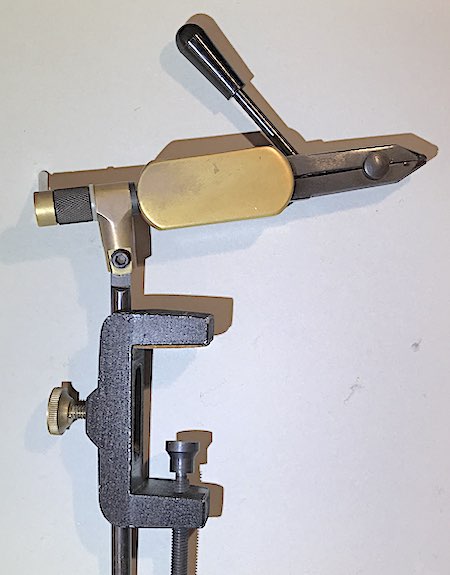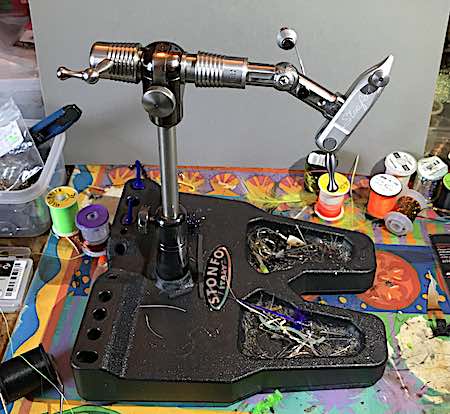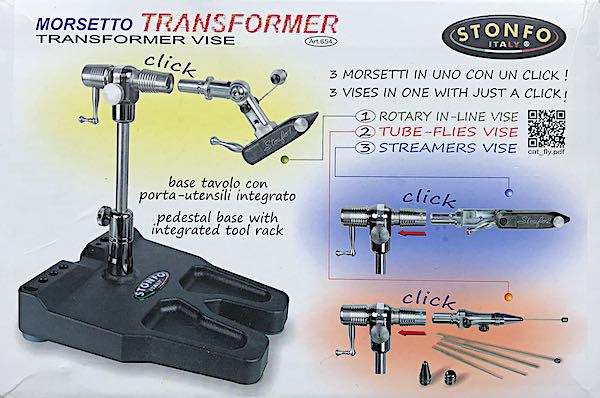Over a year ago, I upgraded to a Stonfo Transformer rotary fly tying vise after using one with a static head for half a century. Since then, a few anglers have asked about the vice I use. Therefore, I decided to write this review on why I switched to a Stonfo Transformer vise?
I upgraded for a combination of reasons but mainly because I would be spending more time tying flies having just retired.
My simple tying vise had served me well and is still going strong, tying trout and grayling flies, but it had always been a…
- fiddle tying salmon and sea trout tube flies with it
- and its grip wasn’t strong enough for large hooks for tying pike and saltwater flies.

Therefore, I decided to buy a fly tying vise, which would enable me to tie almost any kind of fly with ease…
Rotation makes it easy to tie more advanced flies
How do you use a rotary fly tying vise?
This Stonfo Transformer vise comes with 3 sets of interchangeable jaws and accessories, which will enable most types of flies to be tied.
Changing between vice heads is very easy using the fast coupling on the stainless-steel shaft. It only takes one click of the coupling to convert from the precision in-line vise to either the streamer vise or the salmon tube vise.
Effectively, it’s three Vises in one.
The upright shaft of the vise is connected to a solid pedestal base that is large enough and padded to provide stability when in use.
The base has two wells for holding materials, hooks, beads, etc., and an integrated tool rack along the back to hold frequently used tools.
The stainless-steel shaft on the Transformer vise rotates on precision ball bearings and has a device for adjusting tension.

This feature helps in tying flies with evenly spaced ribs and palmered hackles.
What is a true rotary fly tying vise head?

The in-line head is the one I use for most of my fly tying. It has a powerful set of tapered jaws that will firmly hold hooks from size 2 down to size 22 and smaller.
An easy-to-use locking arm firmly fixes the hook within the jaws without the need for excessive torque.
The spring material clip can be located in two positions on the jaw head using a round nut, which is easy to tighten with your fingers.
The Streamer jaws for the Stonfo rotary fly tying vise

The Transformer steamer head for the Stonfo rotary vise is a robust set of jaws for tying large flies, i.e. pike and saltwater flies.
It incorporates a counter leaver hook locking arm, which in the locked position lays flush with the shaft. Also, the spring material clip can be attached to the jaws.
I’ve found it easy to tie pike flies at least size 5/0 hooks (the largest flies I’ve tied to date). Also, I prefer to use this head when tying large sea trout flies, such as surface lures and stingers.
Tube fly tying head attachment

The tube fly head for the rotary vise comes supplied with 5 tube pins and 2 pin tips:
- 3 tapered pins with varying diameters
- 2 straight pins in two diameters
This pin combination allows you to tie flies on most tube designs without the need to buy additional attachments.
Tying tube flies using straight pins can be frustrating because it’s difficult to apply tension on the tube to stop it from slipping on the pin. However, this is overcome using this head by screwing out the pin-tip to lock the tube onto the shaft.
Additional pins are available from Stonfo, but the pins supplied with the vise have so far covered all my fly tying needs. Also, the material spring clip can be attached to the tube fly head.
Summary
Over the last 18 months, I’ve tied hundreds of trout, grayling, and salmon flies with the new vise.
I’ve also started tying pike and saltwater flies on hook sizes to 4/0…
Overall, the Stonfo Transformer rotary fly tying vise has significantly improved the ease of tying flies and was definitely worth the investment.


I have just started fly tying and bought a fairly cheap rotory vice. As I progress in fly tying I will upgrade, thanks to your blog I now see a few things I mist. And will look for when upgrading.
Thank you
Hi Tony,
You will be able to tie most things with a cheap vise. I know I did for years.
Thanks for the comments. Cheers, Andrew
Interesting Piece . I’ve still got the static kind . Thanks Andrew
Hi Tim,
There nothing wrong with a static vise if it allows you to tie the flies you want. I used one for nearly 50 years.
Cheers, Andrew
Great article, thorough and in depth about the vice, very useful, I wish others could learn to be so precise about their own products! Many thanks.
Hi Robert,
Thank you for the feedback and I’m glad you found the article interesting and uselful.
Cheers, Andrew
I feel same. I bought on about 12m ago now for the same reason plus like you retired and having more time, so a belated gift to myself. the one draw back that i find is the the material spring, with the movement of the jaw the screw fixing come loose. a great vice
Hi Tony,
I found the same with the material spring clip but I added a small spring washer behind the nut and it seems to stop it from coming loose.
Cheers, Andrew
Still using thd old static. It certainly makes for difficulties with some flies, The rotary vice ix a very attractive proposition . Food for thought though.
Hi Graham,
My experience is that if you tie salmon and pike flies a rotary vise definitely makes everything much easier.
Thanks for your comments, Andrew
Andrew,
Like you I had worked for many years with a fixed head vice. It did a job but had its limitations.
Around three years ago I invested in a Stonfo, not quite the model you picked, but the Flytec Leva, which has helped me tie more well formed flies.
The stability, materials bins and rotary action, which can be tensioned to a rotation speed that suits you personally plus the parachute and tube fly tools included in the overall package have certainly made a difference to my performance.
A very different experience to my first vice!
The only downside is that the interchangeable vice jaws, a set of three as with your vice, can loosen in the knurled screw fitting that secures them, which causes the odd problem, easily solved by retightening the holing nut. Your set up I suspect avoids that glitch, but you gets what you pays for.
The brand was recommended to me by a Guide I know fairly well and overall I have been very impressed with the vice.
Thank you for this and all your other very informative posts.
Tight lines.
Alan
Hi Alan,
Pleased to hear you enjoyed the post and thanks for your comments.
Tight lines, Andrew
Thank you Andrew for you rewiev , as you can understand I’m Italian , I knew personally the man that collaborate before he died to develop and design the STONFO vices , Piero Lumini a famous Italian flytyer , we have thousands of defectes but in the same time that strange paranoid and obssession for the details and a beautiness when we build somenthing ,as it’s well expressed on this beautifull vice , ‘by the way less expensive than others top brand competitors barely decently featured .
A good investement for who is thinking to buy a good vice on which trust for a serious flyting activity.
Great to hear you are also enjoying tying flies with a Stonfo fly-tying vise.
Tight lines, Andrew
Hi Andrew,
a very comprehensive review and like you I use a rotary but still have several static headed vices. As long as the jaws hold the hook firmly and without damaging it then I reckon most vices will do the job. The more expensive look better and if you don’t tie salmon, pike or tube flies then there is no need to spend more than a couple of hundred on a top of the range beast and then it is only for aesthetic looks. There is plenty of service to be had from a bog standard £25/30 vice.
Hi Iain,
I made the first vice I used in the metal working class at high school. I used it for many years until I bought a bog standard one for a few pounds, which was used for many more years. However, I wished I’d upgraded to a rotary vice sooner than I did.
Thanks for your comments, Andrew
Hi Andrew great Review on the stonfo transformer, l bought one in 2015 year before I retired after tying for 40years +, They are a super vice, Tight lines for the rest of the season.
Hi Paul,
Great to hear you enjoyed it and thanks for your feedback.
Tight lines, Andrew
Hi Andrew,
Great review of the Transformer. I invested in one not too long ago and have to say its a joy to use. Tying tube flies with the tapered pins is great!
I wondered if you have maybe had the same experience as me, where I feel the shaft that connects to the base can be slightly wobbly? Perhaps I’m maybe being a bit too rough, but I noticed the shaft that connects to the base has a notch in it. I’m guessing you line that notch up with the screw on the side that fixes the shaft in place?
Even after trying that I’m still noticing a slight wobble, perhaps I just haven’t set it up or fine tuned it enough yet. Just wondering if you have had the same experience?
Best Regards
Robert
Hi Robert,
It’s great to hear you enjoyed the article. The shaft was slightly loose. So I just wrapped a little insulation tape around the end and it solved the problem.
I hope this helps
Fantastic, thanks for the tip Andrew I’ll give that a go 🙂
Let me know how you get on.